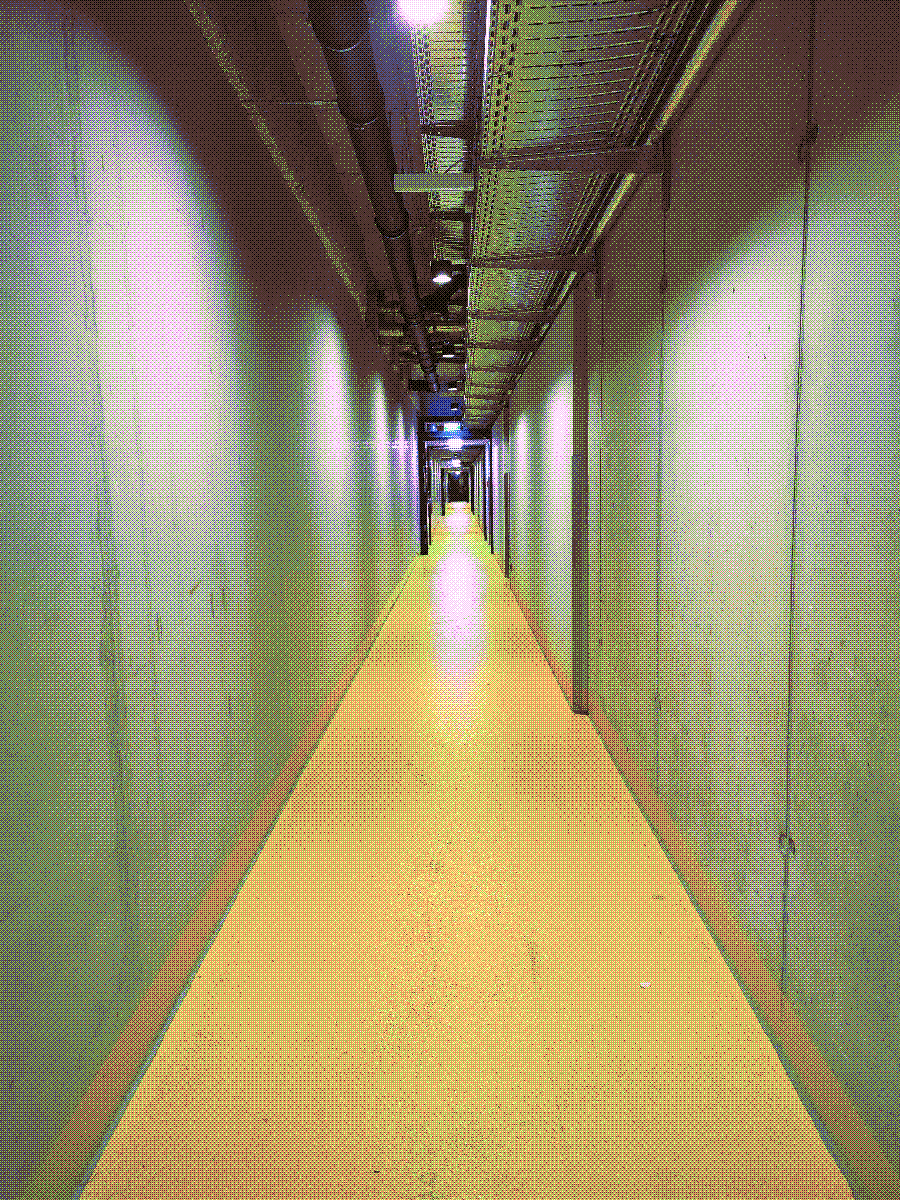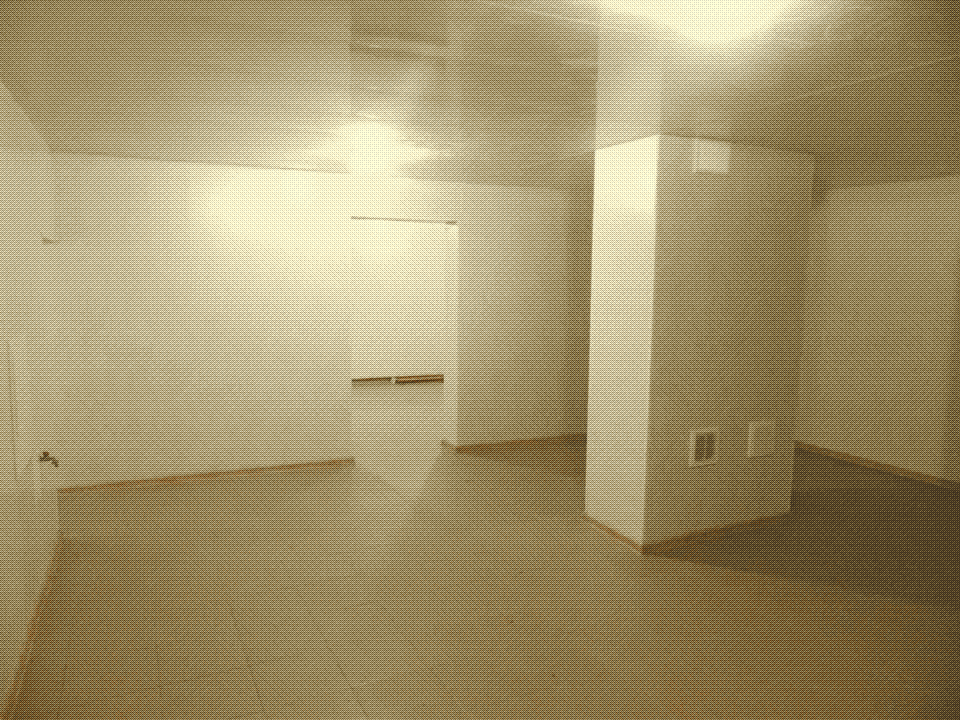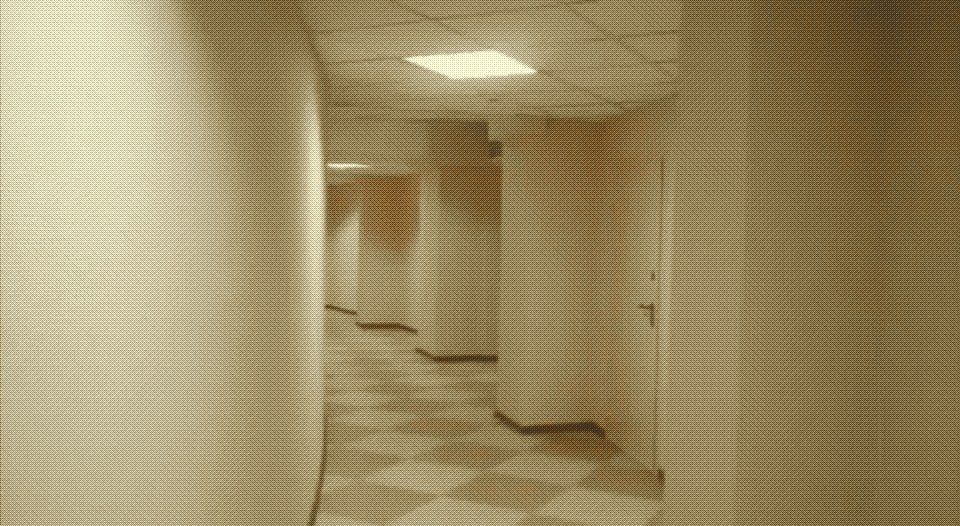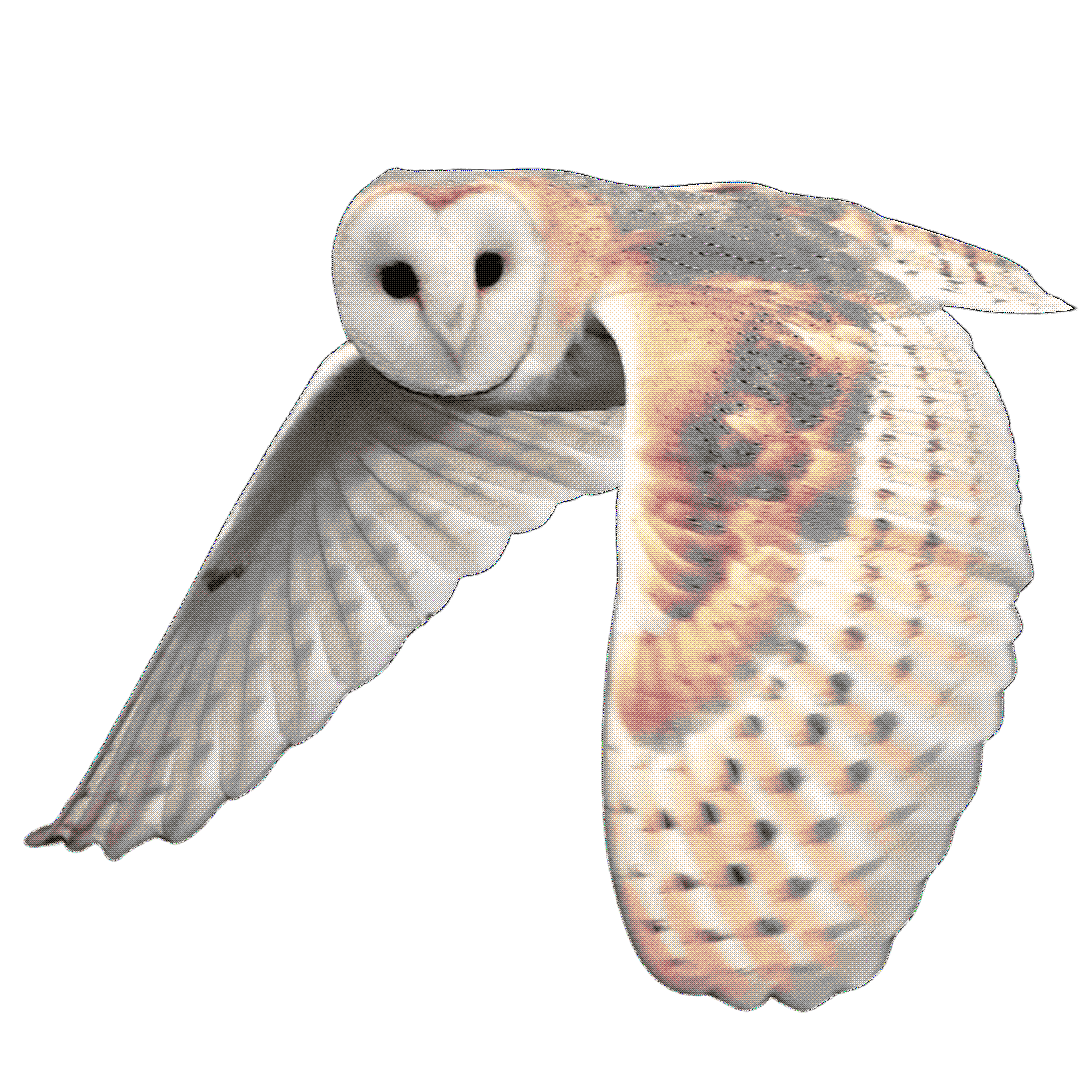Can also be found in this zine.
“So the prototype for labyrinths is, in a word, guts. Which means that the principle for the labyrinth is inside you. And that correlates to the labyrinth outside.” — Haruki Murakami, Kafka on the Shore
Imagine scrolling through your phone and happening upon an image simultaneously so mundane and yet so startling that you cannot help but linger on it. Perhaps it is an edited image of an empty hallway with a sickly beige carpet and yellow fluorescent lighting. Or maybe it’s a photo of a stairwell taken at a slight downward angle, dimly lit by the red glow of an exit sign. Whatever the image, it’s undeniably creepy in its stark emptiness, yet something about it is just familiar enough to evoke a sensation close to nostalgia or deja vu. Maybe you’ve visited this place in a dream. You have just stumbled upon a piece of Internet folklore known as “the Backrooms.”
The Backrooms legend was born in May of 2019, when an anonymous user on the forum website 4chan posted a photo of an empty office space with yellow walls, taken at a dutch angle. An anonymous responder then contributed their own lore to the photo, posting that “if you’re not careful and you noclip [slip] out of reality in the wrong areas, you’ll end up in the Backrooms, where it’s nothing but [...] approximately six hundred million square miles of randomly segmented empty rooms to be trapped in” (Pyle). Other Internet users took this concept and ran with it, creating short stories, short films, video games, art, and most importantly, an ever-growing library of Backrooms photos. While some creatives have populated the Backrooms with monsters and accumulated dense reams of lore regarding them, many argue, (myself included), that the photos by themselves are haunting enough; and it’s the photos that people think of upon hearing the term “Backrooms.”
.png)
The aggressively 21st century aesthetic of most Backrooms photos is visually at odds with the gloomy, imposing images of ornate haunted houses in classic Gothic literature. As primary examples of the haunted house motif, Shirley Jackson’s Hill House and Edgar Allen Poe’s House of Usher are old, dark, elaborately decorated and embellished, and dense with history. Meanwhile, the Backrooms are empty, often harshly lit, and essentially anonymous, even history-less. Regardless, the effect is the same: they cast upon the viewer/reader both an unease and an attraction. What connects these sites of horror is not a common aesthetic or shared narrative, but their “particular kind of architectural space” in which “the Gothic takes root” (Matek). Rather than viewing Hill House and the House of Usher as haunted, possessed, or cursed by spirits, entities, or energies, I would like to apply the conceptual framework of the Backrooms to argue that it is the architecture itself which haunts.
It’s striking that in “The Fall of the House of Usher,” the afflicted Roderick Usher creates a painting whose description could be applied just as easily to a Backroom: it is an image of “an immensely long and rectangular vault [...], with low walls, smooth, white, and without interruption or device. [...] No outlet was observed in any portion of its vast extent, and no [...] artificial source of light was discernible; yet a flood of intense rays rolled throughout, and bathed the whole in a ghastly and inappropriate splendour” (Poe 98). Usher’s painting suggests more than a little similarity between the classic Gothic and modern “liminal” space. For one, these structures, when stripped of their more obvious aesthetic qualities like lighting, color, and decoration, share a peculiar kind of geometry in their composition. Gothic haunted houses are often made up “with edge, sharpness, angularity, [and] corners” (Matek). Similarly, a typical Backroom involves sharp corners and photos of them are often taken at angles which accentuate the sharpness of the lines which make up the space. Tiled floors and ceilings, oddly placed rectangular pillars, and randomly protruding walls are all common motifs which make up these photos. Such imagery directly mirrors Hill House, which “had an unbelievably faulty design which left it chillingly wrong in all its dimensions” (Jackson 28). Additionally, Gothic spaces and Backrooms share a quality of suggested endlessness. The cavernous rooms of the House of Usher are such that “the eye [...] struggled in vain to reach the remoter angles of the chamber” (Poe 94). Hill House is “a masterpiece of architectural misdirection” where every room seems to lead to more rooms (Jackson 78). In the very same tradition of Gothic endlessness, Backrooms “almost always signal ambiguously to some other room or space through a doorway, dark passageway, some blip in the claustrophobic space” (Pyle). If Usher’s painting can be seen as the stripped down essence of his experience within his haunted house, then the Backrooms as a whole serve as the stripped down essence of the Gothic structure.

This form of architecture has a distortive effect on spatial experience. It creates an atmosphere of liminality, causing the viewer’s consciousness to balance on the precipice between sense and nonsense. The apparent impossibility of certain combinations of angles is almost hostile to the human eye and brain. Our faculties are challenged by such a space as “it shapes itself according to a scale — and a (meta)physics — both inscrutable and repulsive to humans” (Matek). In these places, a person’s two senses of reality collide; there is tension between what they can clearly see is, and what their knowledge and rationality tell them should be. As Dr. Montague says, “we have grown to trust blindly in our senses of balance and reason” and in the face of a Gothic structure like Hill House, “the mind might fight wildly to preserve its own familiar stable patterns against all evidence that it was leaning sideways” (Jackson 78). In a haunted house or Backroom, “it seems that there are no boundaries between realities, time, space, and thoughts” (Koch). A person becomes haunted in such an environment, not by any particular entity, but by the gap that opens between their sensorial and rational understandings of space.
The labyrinthine nature of these locations further confuses the senses. Rooms and corridors are situated together in complicated configurations which defy the typical logic of architecture. Anyone unfortunate enough to find themselves lost in these places experiences a “lack of orientation” which “is bound up with the impression of the uncanniness of a thing or incident” (Jentsch). This is a recurring motif in Gothic haunted houses. Hill House is arranged in a concentric fashion, which constantly confuses the characters, causing them to lose their way simply trying to get to the dining room for breakfast. In “The Fall of the House of Usher,” the narrator describes passing “through many dark and intricate passages in [his] progress to the studio of his master” (Poe 93). It appears the rooms of this oversized house are accessible only by maneuvering through countless halls that snake through the building. Similarly, the Backrooms are explicitly understood to be maze-like. Fans of the legend immerse themselves in the world of the Backrooms with the intent that they “will likely feel the same existential quandary of being stuck in a labyrinth of never-ending rooms” (Pyle). The confusion of a labyrinth provokes extreme emotions from either end of the scale, such as Eleanor’s giddiness as she thinks she may be “the first person ever to find Hill House charming” or Poe’s narrator’s “utter depression of the soul” when faced with the House of Usher (Jackson 69; Poe 90). Mazes also have an absorptive effect in which a sense of self is devoured by one’s surroundings. In The Haunting of Hill House, “the continuous shifting of location only serves to further emphasise the helplessness of the team, who seems to be slowly consumed and appropriated by the house” (Matek). In “The Fall of the House of Usher,” Roderick Usher’s selfhood is so irrevocably intertwined with his house that the end of one equates to the end of the other. The existentialism of the Backrooms reflects this phenomenon of self-dissolution, as they are supposedly a place from which one may never escape, where identity breaks down in the absence of orientation and understanding. Labyrinths have a nearly paranormal effect on the human mind, which it causes to sit in an indescribable position of fascination, discomfort, disorientation, and even pleasure.

A guest to a haunted house or Backroom not only finds their perception of space warped, but also their perception of time. Haunted houses in the Gothic tradition are usually placed at a distance from towns or cities, and a primary characteristic of the Backrooms is their literal existence outside of reality. Windows are usually absent in the Backrooms, as they are in the inner rooms and corridors of Hill House and the House of Usher. Thus, in either place, a visitor can be physically incapable of validating the year or era they exist in, or sometimes even the time of day. The visitor does not just lose track of time in these places, but feels as if they exist outside of it entirely. The anachronisms of these locations double the effect. The House of Usher is an extremely old estate, presumably as ancient as the family that owns it, and Hill House is roughly 80 years old. Both of these houses are relics of times long past, not updated, renovated, or even re-decorated to bring them into harmony with the current time. The Backrooms may lack any knowable history as they are meant to be as vague as possible, but they exemplify that which has been left behind as we move forward through the 21st century. For the past few decades, it is less so old mansions which emerge as relics of a bygone time, but the countless anonymous sites of turn-of-the-century life. In an interview with Vice, Backrooms story writer Chris Frewerd notes that “so many people grew up in the odd transitional period of the 2000s, where things from the past sat almost completely unchanged, unmaintained, buildings unrenovated.” Gothic houses and Backrooms form an uneasy relationship with one’s situation in time and history by “abstracting markers of human life, [...] leaving us to roam amongst architectures no longer signifying meaning” (Pyle). In Hill House, the House of Usher, or a Backroom, there are no social indicators of time. These are places that are architecturally and/or aesthetically out-of-sync with the modern world, and without any access to society in the immediate vicinity, you’re left afloat in the maelstrom of time.
Counterintuitively, these sites of haunting often also produce nostalgia in their visitors. The effect of spatial configuration on memory recollection is unique in that “the memory of place is a visceral and primal memory resistant to all modes of rigid abstraction” (Trigg 244). For instance, on her first day at Hill House, Eleanor says “I’m sure I’ve been here before [...] in a book of fairy tales, perhaps,” while Theodora compares it to her time in boarding school (Jackson 37). This unsettling house, for all of the unease it causes, also draws comparison to the locales of childhood memory for these characters. The narrator of “The Fall of the House of Usher” notes that the house was decorated with “matters to which [...] [he] had been accustomed from [his] infancy,” and though “[he] hesitated not to acknowledge how familiar was all this — [he] still wondered to find how unfamiliar were the fancies which ordinary images were stirring up” (Poe 93). At Hill House, the uncanny structure causes the characters to reminisce pleasurably on childhood matters; while at the House of Usher, the familiar vestiges of childhood cause further discomfort. This phenomenon of “nostalgia-horror” lies at the core of the Backrooms, which play off of the shared cultural experiences of early childhood for Generation Z. The creator of the Reddit page r/TrueBackrooms describes Backrooms photos as filled with a “feeling of longing and nostalgia,” which “even [gives] way to a bit of anxiety” (Lloyd). Videos on social media tagged as #Backrooms or #LiminalSpaces often amass many yearning, melancholic comments like “I miss places and people I never met and I miss a life I never had” or “felt like I went back in time to a lost memory.” While suspended between the rational and the irrational, that which lies deepest in consciousness — childhood memory — finds its way back to the surface.

As much as these haunted and liminal places signify the loss of the past, in some ways, Eleanor, Roderick Usher, and those trapped in the Backrooms are all wading through a “nostalgia for lost futures” (Yalcinkaya). Usher is obsessed with holding onto his home, even as it crumbles around him, as there’s some part of him that hasn’t given up on the future of stability and prosperity that the house promises. When Eleanor thinks “what I want in all this world is peace, [...] a quiet spot up among the flowers where I can dream and tell myself stories,” she captures the spirit of a whole generation of teenagers and young adults who yearn for a simplicity they’ve long given up on, and which, against all odds, finds life in the Backrooms (Jackson 143). As is the case for Eleanor, viewers of the Backrooms find childhood memories, fantasies, anxieties, and terror collapsing together. A place can easily horrify, but what turns it into a place of haunting is the peculiar comingling of longing with horror.
A place haunts when its very structure makes us aware of the blindspots in our understanding of reality. There is a frighteningly existential element to realizing how wide the gulf is between the world and what we understand about it. When that gulf is exemplified by a place built with human hands, something we should presumably have control over or at least be able to fathom, it “contributes to the destabilisation of the illusion of ordered and governable life” (Matek). Staring into infinite space or an expanse of sea and momentarily re-situating yourself as small and insignificant is an awe-inspiring but predictable experience. However, trying to find your way through a house built at all wrong angles and realizing your brain is limited in its ability to comprehend reality is a startling reminder of the limits of our minds. In such a situation, we’re presented with two options: accept the limits of our mental faculties and therefore acknowledge we live our lives within a functional illusion; or continue to assert our understanding as infallible and thus continuously falter while in places that defy that understanding. Either decision will doubtless lead to anxiety, discomfort, unease, horror, confusion — haunting. Therein lies the power of a haunted house’s ambiguity: it does not actually matter if a place is haunted by a dead soul, possessed by a malevolent entity, or stalked by a monster. The Backrooms illuminate how in a haunted place “it is not ghosts that are to be feared,” but “reality itself” (Wilson). The walls themselves have the power to push us into alternate dimensions of thought, to warp our understanding of time and space. What haunts us most is a place’s ability to make us aware of the dark matter in our own consciousness.
Works Cited
- Jackson, Shirley. The Haunting of Hill House. Penguin, 2006 edition.
- Jentsch, Ernst. 'On the Psychology of the Uncanny', 1906. Trans. Roy Sellars, Angelaki, vol. 2, no. 1, 1995, pp. 7-16.
- Koch, Karl Emil. "Architecture: The Cult Following of Liminal Space." Musee, 2 Nov. 2020.
- Lloyd, Andrew. "The Backrooms: How a Creepy Office Photo Became an Internet Bogeyman." Vice, 29 Mar. 2022.
- Matek, Ljubica. "The Architecture of Evil: H.P. Lovecraft's 'The Dreams in the Witch House' and Shirley Jackson's The Haunting of Hill House." CounterText, vol. 4, no. 3, Dec. 2018, pp. 406-423.
- Murakami, Haruki. Kafka on the Shore. Translated by Philip Gabriel, Vintage International, 2006.
- Poe, Edgar Allan. "The Fall of the House of Usher." The Fall of the House of Usher and Other Writings, edited by David Galloway, Penguin, New York City, NY, 2003, pp. 90-109.
- Pyle, Phillip. "An Analysis of the Backrooms - Also Known as the Internet's Horror Rooms." 032c, 11 Apr. 2023.
- Trigg, Dylan. The Memory of Place: A Phenomenology of the Uncanny. Ohio University Press, 2012.
- Wilson, Michael T. "'Absolute Reality' and the Role of the Ineffable in Shirley Jackson's The Haunting of Hill House." The Journal of Popular Culture, vol. 48, no. 1, Feb. 2015, pp. 114-23.
- Yalcinkaya, Gunseli. "Inside the Uncanny World of #liminalspaces TikTok." Dazed, 14 Apr. 2021.
